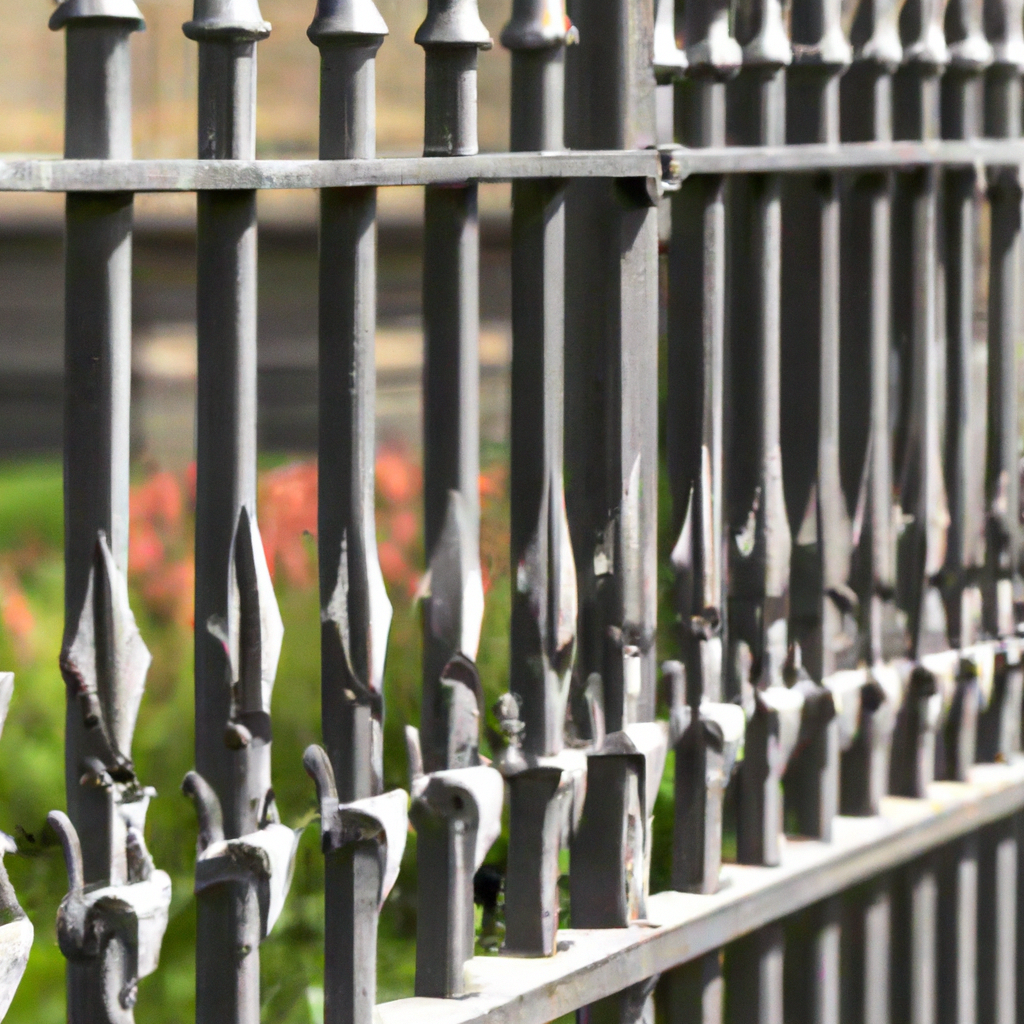Looking to expand your knowledge about fences? Look no further than “http://fencedude.com” – a blog website dedicated to providing comprehensive and engaging content about all things fence-related. With a focus on different types of fences, their sizes, shapes, materials, and suitability for various needs, this blog aims to educate readers on the characteristics and advantages of each fence type. From wooden fences to chain-link, vinyl, and metal fences, you’ll find insights on their durability, maintenance requirements, and aesthetic appeal. By addressing factors like property size, desired level of enclosure, and architectural considerations, the blog offers valuable knowledge and practical advice to help you make informed decisions when selecting and installing fences. So, get ready to dive into the world of fences and discover everything you need to know!
Branding and Security: The Power of Fences for Retail Establishments
When it comes to retail establishments, having a well-defined and secure perimeter is crucial. Not only does it provide a clear boundary for your property, but it also helps to enhance your brand image and ensure the safety of your assets. That’s where fences come into play. Fences offer a range of benefits for retail establishments, from branding opportunities to added security measures. In this article, we will explore the importance of fences, how they can be utilized for branding purposes, the role they play in enhancing security, factors to consider when choosing the right type of fence, and maintenance considerations to keep your retail fences in top shape.
1. Importance of Fences for Retail Establishments
1.1 Creating a Defined Boundary
The first and foremost importance of fences for retail establishments lies in creating a defined boundary. By installing a fence around your property, you clearly demarcate your retail space. This not only helps prevent encroachment from neighboring properties but also sets a clear boundary for your customers and employees.
1.2 Restricting Unauthorized Access
Another crucial aspect of fences for retail establishments is their ability to restrict unauthorized access. With a well-built and appropriately installed fence, you can control who enters your property. This is particularly important for retail establishments that want to maintain a certain level of privacy and control over their premises.
1.3 Enhancing Visual Appeal
Fences can also contribute to the overall visual appeal of your retail establishment. A thoughtfully designed and well-maintained fence can add character and aesthetic value to the surrounding area, making your property more inviting to customers. A visually appealing fence can also help differentiate your retail establishment from competitors and create a memorable impression on potential customers.
1.4 Reflecting the Brand Image
Lastly, fences play a significant role in reflecting the brand image of your retail establishment. The design, material, and customization options of your fence can align with your brand’s identity and values. By incorporating brand colors, logos, or artwork on the fence, you can create a cohesive visual representation of your brand. This helps create a distinct and memorable impression on customers, reinforcing brand recognition and loyalty.
2. Utilizing Fences for Branding
2.1 Incorporating Brand Colors and Logos
One of the most effective ways to utilize fences for branding purposes is by incorporating your brand’s colors and logos. This can be done by painting the fence in your brand’s color palette or adding vinyl wraps with your logo or brand elements. By integrating your brand visuals into the fence design, you create a visually cohesive and recognizable representation of your brand.
2.2 Creating Customized Signage Opportunities
Fences provide ample opportunities for customized signage, allowing you to communicate your brand message effectively. By strategically placing signage on your fence, you can showcase your brand’s tagline, announce promotions, or provide information to passersby. This not only enhances brand visibility but also serves as an additional advertising medium for your retail establishment.
2.3 Using Fences as a Canvas for Artwork or Murals
Fences can transform into artistic canvases, allowing you to showcase your brand’s creativity and personality. Consider commissioning local artists to create murals or artwork on your fence, incorporating elements that align with your brand identity. This adds a unique and eye-catching feature to your retail establishment, making it a landmark within the community.
2.4 Displaying Products or Promotional Messages
If you have specific products or promotional messages that you want to highlight, fences can act as attention-grabbing displays. Use hooks, shelves, or hanging banners to showcase your products or convey promotional messages to passersby. This not only attracts attention but also helps drive foot traffic into your retail establishment.

3. Enhancing Security with Fences
3.1 Deterrence of Theft and Vandalism
One of the primary reasons why retail establishments invest in fences is to enhance security. Fences act as a physical deterrent to theft and vandalism, making it more challenging for potential criminals to gain unauthorized access to your property. The presence of a fence alone can significantly reduce the risk of break-ins and property damage.
3.2 Restricting Unauthorized Entry
Fences also serve as a barrier to unauthorized entry, ensuring that only authorized individuals can access your retail establishment. By implementing secure access points, such as gates with lock systems, you can control who enters and exits your property, providing an additional layer of security for your employees and customers.
3.3 Surveillance Integration with Fences
To further enhance security, fences can be integrated with surveillance systems. By strategically placing CCTV cameras on the fence posts or incorporating them into the fence design, you can effectively monitor the perimeter of your retail establishment. This allows for proactive identification of potential security threats and aids in the deterrence and prevention of criminal activities.
3.4 Implementing Access Control Systems
For retail establishments that require higher levels of security, fence integration with access control systems can be immensely beneficial. This can include features such as keycard or biometric access points, intercom systems, or even automated gates. By implementing these systems, you can ensure that only authorized individuals can enter your property, minimizing the risk of unauthorized intrusion.
4. Choosing the Right Type of Fence
Choosing the right type of fence for your retail establishment depends on various factors, including your specific needs, budget, and aesthetic preferences. Here are some popular fence types commonly used in retail establishments:
4.1 Wooden Fences
Wooden fences offer a timeless and traditional look, providing a warm and inviting atmosphere for retail establishments. They are versatile, customizable, and can be stained or painted to match your brand’s colors. However, wooden fences require regular maintenance to prevent rotting and warping.
4.2 Chain-Link Fences
Chain-link fences are a popular choice for retail establishments due to their affordability and durability. They provide an unobstructed view of the property and offer excellent security. Chain-link fences can be enhanced with vinyl or slats for added privacy and to incorporate branding elements.
4.3 Vinyl Fences
Vinyl fences are low-maintenance and highly customizable, making them an attractive option for retail establishments. They are available in various styles and colors, allowing you to find the perfect match for your brand image. Vinyl fences are resistant to rot, moisture, and pests, offering long-term durability.
4.4 Metal Fences
Metal fences, such as aluminum or steel, offer a sleek and modern appearance. They are strong, durable, and require minimal maintenance. Metal fences can be customized with decorative elements and are available in different heights and styles to suit your security and branding needs.
4.5 Composite Fences
Composite fences are a blend of wood fibers and recycled plastic, providing the visual appeal of wood without the extensive maintenance requirements. These fences are resistant to rotting, warping, and insect damage, making them a durable and environmentally-friendly option for retail establishments.
4.6 Concrete Fences
Concrete fences offer the highest level of security and are ideal for retail establishments that prioritize safety. They are durable, low-maintenance, and provide excellent soundproofing. Concrete fences can be customized with various textures, colors, and designs to enhance branding efforts.
4.7 Glass Panel Fences
Glass panel fences provide a modern and elegant look for retail establishments. They offer unobstructed views, allowing your products or storefront to be visible while maintaining security. Glass panel fences can be customized with tinted or frosted glass for added privacy and branding opportunities.
4.8 Wrought Iron Fences
Wrought iron fences are known for their classic and ornamental appearance, adding a touch of elegance to retail establishments. They are highly secure and can be customized with intricate designs. However, wrought iron fences may require periodic maintenance to prevent rust and corrosion.
4.9 Bamboo Fences
Bamboo fences provide a natural and environmentally-friendly option for retail establishments. They offer a unique aesthetic appeal and can be customized with various finishes and patterns. Bamboo fences are durable, resistant to rot, and offer good privacy.
4.10 Electric Fences
Electric fences provide a high level of security by delivering a non-lethal electric shock when touched. These fences are typically used as an additional security measure in high-risk areas. Electric fences should be used in compliance with local regulations and guidelines.

5. Factors to Consider for Branding
When incorporating fences into your branding efforts, it’s essential to consider the following factors:
5.1 Brand Consistency and Identity
Ensure that the design and customization of your fence align with your brand’s visual identity and core values. Consistency across all branding elements, including the fence, reinforces brand recognition and creates a unified brand experience for customers.
5.2 Material Compatibility with Brand Image
Choose a fence material that complements your brand’s image. Each material has its own aesthetic appeal, so consider how it aligns with your brand’s personality and the impression you want to create.
5.3 Visibility and Signage Placement
Consider the visibility of your fence and strategically place signage to maximize its impact. Ensure the signage is easily readable and incorporates key branding elements, such as your logo or tagline.
5.4 Customization Options
Choose a fence type that offers ample customization options, allowing you to incorporate branding elements effectively. This could include options for painting, vinyl wraps, or customized signage placements.
6. Factors to Consider for Security
For optimal security, consider the following factors when selecting a fence for your retail establishment:
6.1 Perimeter Height and Strength
Choose a fence height that provides the level of security you require. Consider factors such as the proximity to public areas, the value of your assets, and potential security threats when determining the appropriate height. Additionally, select a fence material that offers the necessary strength and structural integrity to resist unauthorized entry.
6.2 Security Gates and Locking Systems
Integrate security gates with robust locking systems as part of your fence installation. These gates should only allow authorized individuals to enter and exit the property. Consider options such as keycard access, biometric readers, or intercom systems for secure entrance control.
6.3 Surveillance Camera Integration
Ensure that your fence design allows for seamless integration of surveillance cameras. Proper camera placement along the fence line can help monitor potential security breaches and deter criminal activities.
6.4 Anti-climbing and Anti-cutting Features
Select a fence type that incorporates anti-climbing and anti-cutting features, making it more challenging for unauthorized individuals to scale the fence or sabotage its integrity. Options such as spikes, barbed wire, or specialized fence designs can deter potential intruders.

7. Popular Fencing Materials for Retail Establishments
When it comes to choosing fencing materials for retail establishments, several options are commonly used:
7.1 Wood
Wooden fences offer a classic, natural look and can be customized to match your brand’s aesthetics. However, they require regular maintenance to prevent deterioration.
7.2 Metal
Metal fences, such as aluminum or steel, provide durability and versatility. They can be customized with various designs and finishes to suit your brand image.
7.3 Vinyl
Vinyl fences are low-maintenance and highly customizable. They come in a range of colors and styles, offering long-lasting durability.
7.4 Composite
Composite fences combine wood fibers and recycled plastic for a durable and eco-friendly option. They offer the aesthetics of wood without the maintenance requirements.
7.5 Chain-Link
Chain-link fences are cost-effective, durable, and provide excellent security. They are often enhanced with vinyl or slats for added privacy and branding opportunities.
8. Fence Sizes for Different Retail Needs
The appropriate fence size for your retail establishment depends on your specific needs and requirements. Here are some general guidelines:
8.1 Low-Height Fences for Visual Appeal
Low-height fences, such as decorative wrought iron or bamboo fences, are ideal for retail establishments that want to enhance visual appeal without sacrificing security. They provide a clear boundary while maintaining an open and inviting atmosphere.
8.2 Medium-Height Fences for Perimeter Definition
Medium-height fences, typically ranging from 4 to 6 feet, are suitable for most retail establishments. They offer a balance between security and visibility, providing a clear perimeter definition while allowing for easy visibility of your storefront or products.
8.3 High-Height Fences for Maximum Security
For retail establishments that require maximum security, high-height fences are recommended. These fences, often exceeding 8 feet in height, act as a strong deterrent and create a formidable barrier. However, local regulations and zoning restrictions may apply, so ensure you consult with relevant authorities before installing high-height fences.

9. Fence Shapes and their Impact on Branding
The shape of your fence can have a significant impact on your branding efforts. Consider the following options:
9.1 Straight and Vertical Lines
Fences with straight, vertical lines exude simplicity and modernity. This shape can align with a brand that values minimalism, precision, and professionalism.
9.2 Curved and Organic Shapes
Curved and organic fence shapes can create a softer and more approachable impression. These shapes are ideal for brands that aim to evoke a sense of comfort, relaxation, or natural aesthetics.
9.3 Geometric Patterns and Cutouts
Geometric patterns and cutouts on fences offer a unique and eye-catching design element. This can serve to reinforce a brand’s creativity, innovation, or attention to detail.
9.4 Fence Top Variation
Varying the top of your fence creates visual interest and can further contribute to your branding efforts. Options such as scalloped tops, arches, or lattice patterns add a distinct design element, setting your retail establishment apart.
10. Maintenance Considerations for Retail Fences
To ensure the longevity and effectiveness of your retail fences, consider the following maintenance practices:
10.1 Material Durability and Longevity
Choose a fence material that aligns with your maintenance capacity. Some materials, such as wood, may require regular staining or sealing to prevent rotting and warping, while others, like vinyl or metal, offer better durability and require minimal maintenance.
10.2 Regular Cleaning and Inspection
Keep your retail fences clean and free from debris, dirt, or vegetation growth. Regularly inspect the fence for signs of damage, including loose boards, rust, or broken sections. Promptly address any issues to maintain the structural integrity of the fence.
10.3 Repainting and Rebranding
If your fence incorporates paint or vinyl wraps, consider periodically repainting or replacing them to maintain a fresh and vibrant appearance. This is particularly important if your branding elements or color scheme change over time.
10.4 Repairing and Replacing Damaged Sections
Address any damage or wear promptly to prevent further deterioration. Repair or replace damaged fence sections, tighten loose screws or bolts, and ensure all elements are secure. Regularly evaluate the condition of your fence to determine if any upgrades or replacements are necessary.
It’s important to note that the specific maintenance requirements may vary depending on the material, climate, and environmental factors. Consult with fence manufacturers or professionals for detailed maintenance guidelines tailored to your specific fence type.
By understanding the importance of fences for retail establishments, utilizing them for branding purposes, enhancing security, choosing the right type of fence, considering branding and security factors, exploring popular fencing materials, determining appropriate fence sizes and shapes, and being aware of maintenance considerations, you can make informed decisions when it comes to incorporating fences into your retail establishment. Remember that the right fence can not only define your property but also reinforce your brand image and provide a secure environment for your customers, employees, and assets.

Frequently Asked Questions (FAQs)
-
Q: Do I need a fence for my retail establishment? A: Installing a fence can provide numerous benefits, including creating a defined boundary, restricting unauthorized access, enhancing visual appeal, and reflecting your brand image. Assess your specific needs and priorities to determine if a fence is suitable for your retail establishment.
-
Q: Can I incorporate my brand’s colors and logo into the fence design? A: Yes, you can customize your fence by incorporating your brand’s colors and logo. Consider using paint, vinyl wraps, or signage to create a visual representation of your brand on the fence.
-
Q: How can fences enhance security for my retail establishment? A: Fences act as a deterrent to theft and vandalism, restrict unauthorized entry, allow for integration with surveillance systems, and enable the implementation of access control systems such as secure gates and locking systems.
-
Q: What factors should I consider when choosing the right type of fence? A: Factors to consider include your specific needs, budget, desired level of security, aesthetic preferences, and maintenance requirements. Different fence types offer varying advantages, so research and consider these factors before making a decision.
-
Q: How can I use fences to enhance my retail establishment’s branding? A: Fences can be used as a canvas for artwork, customized signage placements, or to display products and promotional messages. Incorporating your brand’s colors, logos, and taglines into the fence design is also an effective branding strategy.
-
Q: What are some popular materials for retail fences? A: Popular fencing materials for retail establishments include wood, metal (such as aluminum or steel), vinyl, composite (wood fibers and plastic), and chain-link. Each material has its own advantages and considerations, so choose based on your specific requirements.
-
Q: How do I determine the appropriate fence size for my retail establishment? A: The appropriate fence size depends on factors such as your desired level of security, aesthetic preferences, and local regulations. Consider low-height fences for visual appeal, medium-height fences for perimeter definition, and high-height fences for maximum security.
-
Q: Can fence shapes impact branding efforts? A: Yes, fence shapes can impact branding efforts. Straight and vertical lines can evoke simplicity and professionalism, while curved and organic shapes create a softer impression. Geometric patterns and cutouts add visual interest, and varying the top of the fence contributes to unique design elements.
-
Q: What maintenance considerations should I keep in mind for retail fences? A: Regular cleaning, inspection for damage, repainting or rebranding as needed, and prompt repair or replacement of damaged sections are important maintenance practices. The specific requirements may vary based on the fence material and environmental factors.
-
Q: How do I ensure the long-term effectiveness of my retail fences? A: Regular maintenance, prompt repairs, and periodic evaluations of your fence’s condition are key to ensuring its long-term effectiveness. Follow the manufacturer’s guidelines, consult professionals as needed, and address any issues promptly to maintain the integrity of your fences.
(Table format)
| Fence Type | Description | Benefits | Drawbacks |
|---|---|---|---|
| Wood | Provides a classic and natural look, highly customizable | Aesthetically pleasing, versatile | Requires regular maintenance |
| Metal | Offers durability and versatility, various finishes available | Strong and long-lasting, low maintenance | Susceptible to rust or corrosion |
| Vinyl | Low-maintenance and highly customizable, resistant to rot and pests | Durable, available in various styles and colors | Can be prone to fading over time |
| Composite | Environmentally-friendly option, offers aesthetics of wood without maintenance | Resistant to rot, warping, and insects | Can be more expensive than other options |
| Chain-Link | Cost-effective, durable, provides excellent security | Promotes visibility, easily customizable | Offers minimal privacy by itself |
| Concrete | Highest level of security, low-maintenance, excellent soundproofing | Extremely secure, durable | Limited design options, higher installation costs |
| Glass Panel | Modern and elegant appearance, unobstructed views | Showcases products, provides visibility | Requires regular cleaning, relatively expensive |
| Wrought Iron | Classic and ornamental, ideal for showcasing brand personality | Adds elegance and sophistication | May require periodic maintenance |
| Bamboo | Natural and eco-friendly option, offers unique aesthetic appeal | Durable, rot-resistant | Limited height options, maintenance may be required |
| Electric | Non-lethal deterrent, enhances security in high-risk areas | Effective at deterring intruders | Must comply with local regulations |
